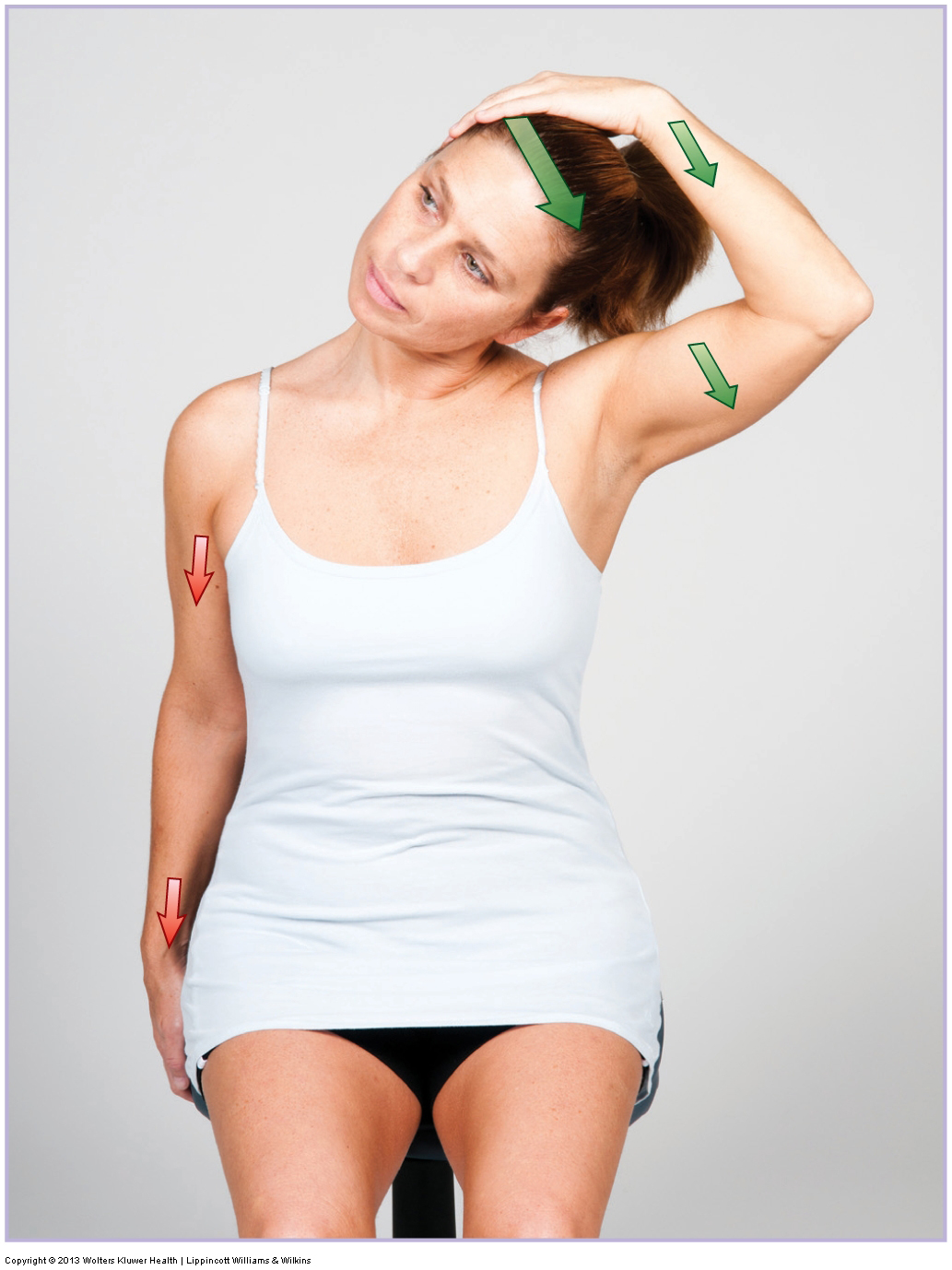Self-care for the client/patient

Oblique plane self-care stretch for the neck. Permission: Joseph E. Muscolino. Advanced Treatment Techniques for the Manual Therapist: Neck (2013).
When acute, rest and ice application should be recommended. Ice should be applied for approximately 5-10 minutes depending on how cold the ice application is. If the condition is severe enough, wearing a neck brace can be recommended to support the neck. However, the client/patient should occasionally remove the brace and perform gentle ranges of motion so that the neck does not excessively stiffen. Clients/patients may also choose to take over-the-counter anti-inflammatory medication.
Once the acute stage is resolved, moist heat followed by stretching of the neck can be recommended. If and when signs and symptoms of the condition have resolved, strengthening the neck musculature should be recommended, especially if the client/patient has experienced a ligamentous sprain.
Medical approach
The medical approach to whiplash is usually to recommend rest, over the counter non-steroidal anti-inflammatory medication or prescription steroidal anti-inflammatory medication (such as prednisone), and use of a cervical collar. If pain is present, pain medication may also be prescribed. If pain persists after the acute stage is over, referral to a physical therapist is often made.
Manual therapy case study
Diana is a 35-year-old high school art teacher who was involved one week ago in an automobile accident. She reported that she was stopped at a light and noticed that a car was quickly approaching her from behind; she tensed and felt the impact. She estimates that the car struck her at around 25 miles per hour. Diana has diffuse widespread stiffness and pain in the back of her neck bilaterally. On a pain scale of 0-10, she reports the pain at a constant 7. She has also been experiencing headaches since the accident.
Diana’s neck is so stiff that it is not possible to perform passive end range of motion to assess the degree of strain versus sprain that has occurred. Diana’s flexion ROM is decreased to 25 degrees; her right lateral flexion ROM is decreased to 20 degrees; her left lateral flexion ROM is decreased to 10 degrees; and her rotation ranges of motion are equally decreased to 30 degrees; only her extension ROM was within normal limits. Diana experienced increased pain bilaterally in her posterior neck with flexion, increased pain in the posterior left neck with right lateral flexion, and increased pain in the posterior right neck with left lateral flexion.
Upon palpatory examination, her entire posterior neck bilaterally was tight and tender to digital pressure. The tightest region was the right upper neck. There were also myofascial trigger points in her right suboccipital region that reproduced her characteristic headache pain. No inflammation was palpable. All tests for a space-occupying (intervertebral foraminal nerve compression) lesion were negative.
It is clear that Diana suffered a whiplash injury. But because her muscles are so tight, end-range passive ROM is not possible so it is not possible to definitively determine the relative degree of strain versus sprain. The fact that she tensed before the impact indicates that muscular strain is likely the greater aspect of the injury. Given the widespread tightness, the first objective of care is to decrease the muscle spasming. The primary region to work is the posterior neck, with the greatest focus on the right upper neck/suboccipital region.
The therapist recommended one-hour massages, every other day for the first week, and every third day for the second week. Each session consisted of approximately 15 minutes of long slow soft tissue manipulation to the posterior neck, starting with light pressure and gradually transitioning to medium pressure, with the client/patient supine. The client/patient was changed to a prone position and heat was placed on her neck for approximately 10 minutes as her upper back and shoulder regions were worked. She was turned to a supine position again and her neck was stretched into flexion in the sagittal plane, each lateral flexion within the frontal plane, and into a combination of flexion with each lateral flexion in oblique planes. Deeper pressure (within her tolerance) was then used in her neck with special focus on the deeper musculature within the laminar groove and in her right upper neck. The remainder of the time was spent working her mid back and upper extremities. As Diana gradually improved with each session, the depth of pressure and the assertiveness of the stretching was increased, but always remaining within her tolerance level.
Diana was given self-care instructions to perform moist heat (hot shower) followed by stretching at least three times per day for the first week. It was also recommended that she avoid or minimize all postures that required her to look down or hold her arms out in front of her, and to not carry a purse on her shoulder.
At the end of two weeks, Diana’s symptoms had decreased approximately 50%. Her range of motion had returned sufficiently that reexamination of her neck with active and passive range of motion (ROM) testing was done and showed pain with active ROM and manual resistance, but no pain with passive ROM. Therefore the therapist felt confident that Diana’s injury was a muscular strain. Joint motion palpation was also assessed, and it was determined that Diana had a number of segmental hypomobilities so the therapist added Grade IV joint mobilization (arthrofascial stretching; AFS) into the care plan and also recommended that Diana see a chiropractic physician for possible Grade V osseous mobilization/manipulation. Care was continued at a frequency of twice per week for another four weeks, at which point Diana reported that her pain and stiffness were nearly gone. She decreased care to once every two to four weeks with the goal of continuing at this frequency of care into the future.


